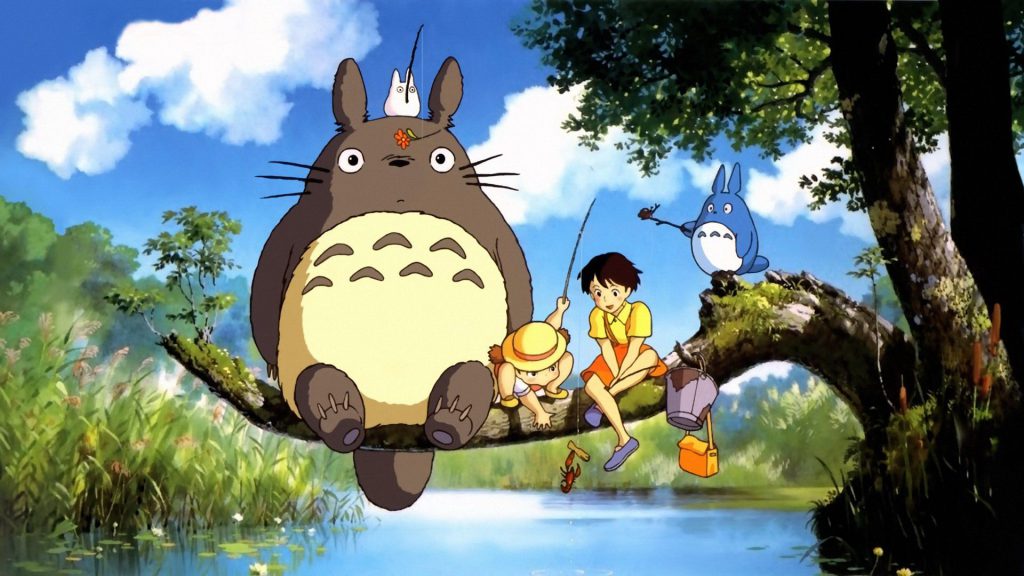My Neighbour Totoro

Ghosts were a normal part of life as a kid. There was a haunted wood across the street from my house, and at the centre of the wood was a pit that would occasionally suck in metres of the surrounding land. We called it the Ditch, and we were the only kids that played there.
We very rarely ventured near the centre of the wood, because the pit was guarded by a tall figure in a long black cloak. Every snapping twig and rustling of the undergrowth was evidence to us that the guardian was on the prowl and keeping an eye on us, and occasionally we’d see it standing silently among the trees.
 I don’t see ghosts anymore, now I’m older and more rational. I miss it, because the world seemed a kinder place with ghosts in it. I visited the Ditch again a few years ago on a trip home, and was amazed how much it had changed. I was able to gain access easily, whereas the undergrowth seemed impenetrable as a child, apart from a few secret entrances only we knew.
I don’t see ghosts anymore, now I’m older and more rational. I miss it, because the world seemed a kinder place with ghosts in it. I visited the Ditch again a few years ago on a trip home, and was amazed how much it had changed. I was able to gain access easily, whereas the undergrowth seemed impenetrable as a child, apart from a few secret entrances only we knew.
When I was little the Ditch seemed like a deep ravine hidden from the world, so it was amusing to find the street level was only a few metres above my head as a (not very tall) grown up. I gained the centre of the Ditch without anything more troubling than wet shoes – the pit was heavily logged with boggy water – and stood face to face with the guardian of the wood. It was a burnt, blackened tree stump a little taller than myself.
[movies-box]
If you have any similar experiences from childhood, your nostalgia glands are likely to be stimulated by Hayao Miyazaki’s My Neighbour Totoro, a beloved animated tale from the early days of the legendary Studio Ghibli. It’s the story of a teacher who takes his two young daughters, Satsuki and Mei, to live in the countryside so they can be closer to their mum, who is convalescing after a long-term illness. They move into a ramshackle house which the girls immediately discover is home to some fuzzy little dust spirits, who decide to vacate the premises once the family gets settled in.
Later, while her dad is working and Satsuki is at school, Mei encounters another supernatural creature, a small walking ball of fluff with rabbit-like ears. She follows it into the woods at the bottom of the garden and into a vast hollow tree, where there is a much larger version of the same ghost who goes by the name Totoro.
The girl’s father and the other grown ups can’t see the spirits, but are totally cool with the idea of living in haunted house and the children hanging out with friendly forest ghosts. This is where My Neighbour Totoro differs from typical family films in the West – there is nothing threatening or sinister about the creatures that Satsuki and Mei meet, and Miyazaki doesn’t feel the need to introduce an antagonist to create some dramatic tension. The film is simply about the joys of being a child, the thrill of investigating a new place, and the blurred lines between imagination and reality. Miyazaki understands implicitly that a child’s view of the world is very different to that of an adult, and he explores this to its full wondrous capacity.
While the plot of My Neighbour Totoro is slight, the film feels rich, with Miyazaki weaving in some familiar themes. He’s concerned about the balance between the natural world and that of humans, and without getting all tree-huggy about it can envision harmony between them. Similarly, unlike much of western cinema, he matter-of-factly depicts the world of the spirits and humans as overlapping and in tune, although it is only children who are able to see the supernatural beings.
It’s a generous worldview, which makes it all the more interesting to know that My Neighbour Totoro was originally released on a double bill with Isao Takahata’s traumatic Grave of the Fireflies, one of the best films I never want to see again. Fireflies is a harrowing account of human collateral damage during wartime, about two children left to fend for themselves after their city is firebombed by the US during WWII. They represent completely opposite ends of a childhood experience – the girls in Totoro are safe and happy, the brother and sister of Fireflies homeless and starving.
My Neighbour Totoro is showing as part of a cycle of Miyazaki’s films at Kino Scala at the end of January, and they’re a good choice for this time of year. Full of light and beauty, they’re great movies to help you get through the post-holiday slump and all cheered up ready for spring!

